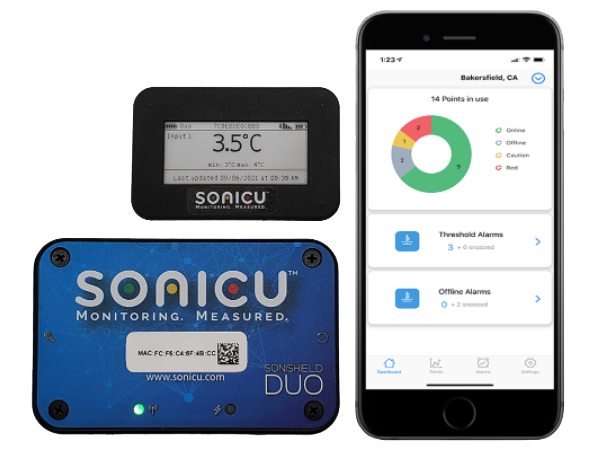
Identifying Open Door Threats in the OR to Reduce Surgical Site Infections
Operating rooms may be among the most tightly regulated environments in healthcare facilities, Sonicy helps ensure they're safe and monitored correctly.
Designed with safety, efficiency and compliance always top of mind, we’ve evolved over a decade with continuous improvements from customer feedback. Serving the healthcare, research and food service industries.
Sonicu offers a comprehensive suite of monitoring solutions
that help organizations safeguard assets, automate compliance and reduce manual processes.
Sonicu offers a comprehensive suite of monitoring solutions
that help organizations safeguard assets, automate compliance and reduce manual processes.
From protecting vaccines and research materials to safeguarding food service and facility operations, Sonicu’s monitoring applications cover temperature, humidity, pressure, and more. Whether you’re in healthcare, life sciences, food safety, or other industries, Sonicu provides visibility, compliance, and peace of mind across all your critical applications.

Understanding Heat Stress and OSHA Regulations: How to Protect Your Employees and Ensure Compliance

The Occupational Safety and Health Administration has placed a notice to employers nationwide in regards to rising temperatures.
According to their notice, federal inspectors can stop by worksites unannounced, both indoors and outdoors, to ensure workers are safe from heat exposure.
This notice comes from the establishment of their new NEP: National Emphasis Program.
Thanks to the work of this program, OSHA inspectors will be able to target workplaces in more than 70 industries that are at “high risk” for heat exposure.
The best examples of high-risk industries include agriculture, warehouses, and construction.
Though the program is the Administration’s first for heat, enforcement tools like this program are important as they save lives.

Expect Your Unexpected Guests
Under the guidelines of the program, inspectors are allowed to visit workplaces that were once limited to only being seen after receiving complaints or workplace injuries and fatalities.
With their visits, inspectors can assess whether workers are being protected and safe from high heat as well as other hazards.
This program is a part of the Biden Administration’s broader efforts to address the effects of climate change through the use of a “whole of government approach.”
In the words of Vice President Kamala Harris, “Heat is a workplace safety issue… And employers are responsible for protecting their workers in the workplace from the dangers of heat, including in farm fields, in delivery vans, and in nursing homes— everywhere that has workers” (Wittenberg).
“We want to be proactively addressing heat hazards," said OSHA Deputy Assistant Secretary Jim Frederick while explaining the importance of this program.
“Without an emphasis program, we can see a hazard and address it if we are already in a workplace, but this gives us the ability to proactively go to these workplaces and see what heat protections they have in place.”
He continued by stating that the emphasis program is “a tool that helps us make certain we are reaching workers we might otherwise not because they might not want to call us and ask for help.”
He explained that the emphasis program allows inspectors to ask for help and have a say in their occupational safety conditions and implementation methods.
OSHA compliance workers are currently doing consultations with employers.
These consultations include visiting worksites and explaining what needs to be done in order to make it safer.
However, formal inspections that can result in citations for violations will begin soon.
The National Emphasis program became effective on April 8, 2022, and triggers heat-related inspections.

What Changes Can Employers Expect?
When the heat index is expected to be 80℉ or become a “heat priority day”, OSHA will inquire about heat-related hazard prevention programs during inspections.
OSHA will be selecting employers for pre-planned inspections to occur in areas given a heat warning or advisory in high-risk industries, including but not limited to:
The program also includes OSHA referring to information from the Wage & Hour Division of the Department of Labor about investigating reported inadequate working and living conditions, as well as wages (LLP).
The program also includes steps that OSHA must take in inspecting heat-related hazards, including:
Heat Regulation is in the Works for OSHA
There are plans about other things that OSHA can do to protect workers from heat.
Juley Fulcher, Worker Health and Safety Advocate at Public Citizen, explained that while the program is a good thing, there is a limit to how big an impact NEP can have without specific and federally mandated standards that tell employees exactly what they need to do to protect workers from heat.
OSHA currently has no heat regulations.
Right now, they are relying on the “general duty clause,” which broadly requires employers to ensure workplaces are safe from “recognized hazards.”
This clause presents a potential struggle as issuing citations for heat hazards based on a small clause inside of another mandate is only a fraction of the Administration’s full authority.
Fulcher questioned and criticized this clause by saying that “there is such a high burden to issue a heat citation under the general duty clause now that they can only do anything with the most extreme cases,” Fulcher said.
“That’s why a heat rule would be so important, because when you cite someone, you could say, ‘Here it is, written on paper, here is what you had to do that you didn’t do."
OSHA has given justifications varying from a lack of funding, despite fiscal budgets of almost $20 million, and the prioritization of infectious disease protections during the pandemic.
However, heat is not a complicated challenge to regulate.
While regulations can take more than seven years to finalize, the Administration has combated this through the passing of infectious disease and toxic and carcinogenic chemical exposure, despite these being either rare or new and currently evolving.
OSHA has already taken the first step towards establishing a federal heat standard.
In October 2021, OSHA released an Advanced Notice of Proposed Rulemaking (ANPRM) for Heat Injury and Illness Prevention in Outdoor and Indoor Work Settings.
OSHA is currently using the information gathered from this to work on establishing a federal rule for heat stress.
What Employers Can Do: Protecting Your Staff and Operations.
However, there are plenty of work and actions that employers can do to ensure the safety of the workplace for employees.
Under the program, employers can request a consultation.
Spanish Fort System Superintendent Jason Evans explained his consultation experience with SafeState, a University of Alabama program through OSHA NEP, in his own blog post.
He explained that the consultation included:
He explained that the result of the consultation was an increase in employee safety and awareness by allowing both parties to ask:
“Is there a better way to accomplish my tasks and workplace safety?”
His advice for other small businesses was to take advantage of programs such as SafeState.
Programs such as SafeState are vital, but not the only step that employers can take to ensure workplace safety.
Constant monitoring is key to ensuring safety practices are being properly enabled in managing environments.

Stay Ahead of the Inspections With Sonicu
Sonicu is the perfect monitoring tool as it uses manufactured sensors to easily monitor temperature, sound, humidity, air pressure, and other data.
The platform can be adjusted to your preferences, and 24/7 monitoring data can be accessed through Wi-Fi, Ethernet, and even a cellular modem.
This data can be auto-formatted into standardized and custom reports for regulatory compliance or advanced analytical reporting to measure the metrics important to your business.
OSHA recommends employers take certain steps to protect their employees and themselves, including:
Sonicu also provides custom solutions to help you meet your specific business objectives and OSHA standards.
Sonicu is the number one choice for hospitals, health departments, research facilities, manufacturing, and cold storage warehousing.
The platform includes many benefits and is essential to ensuring your business success, so schedule a demo to find out how you can improve your business today.
Sources:
Subscribe to our newsletter for expert insights, product updates, and strategies to keep your operations running smoothly.

